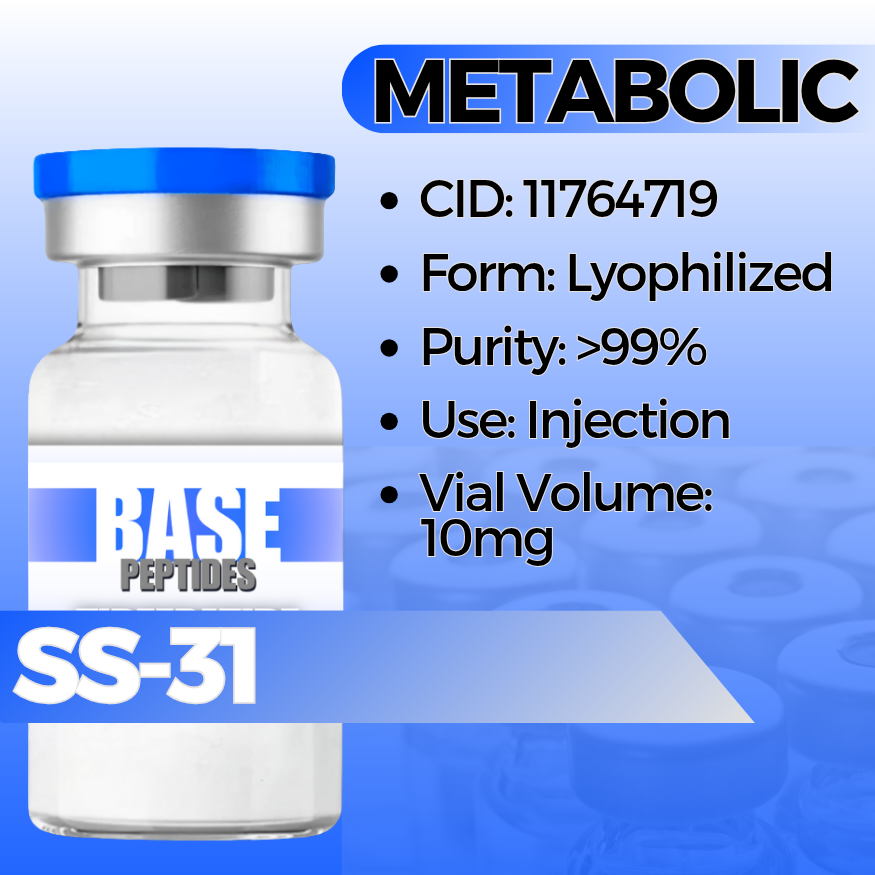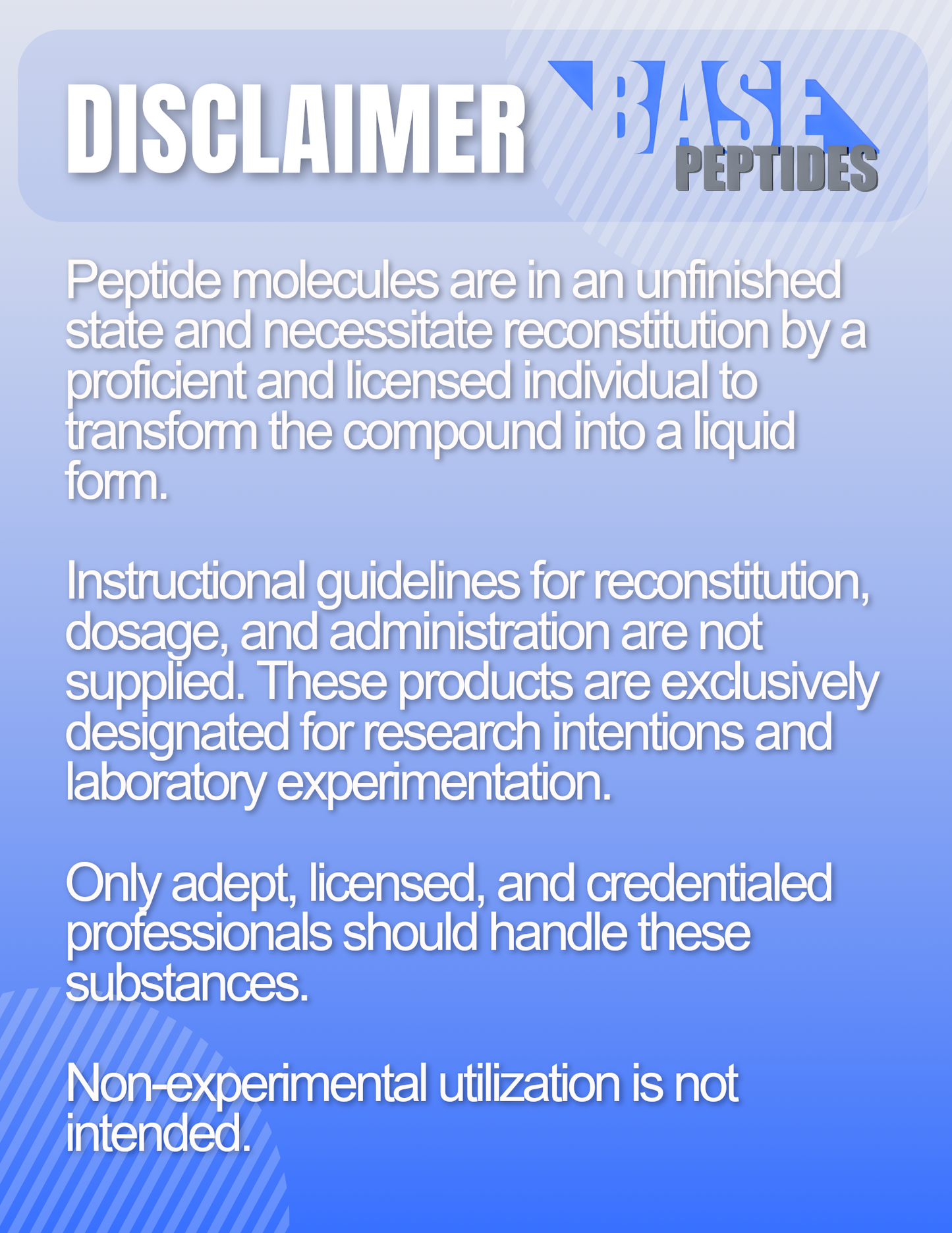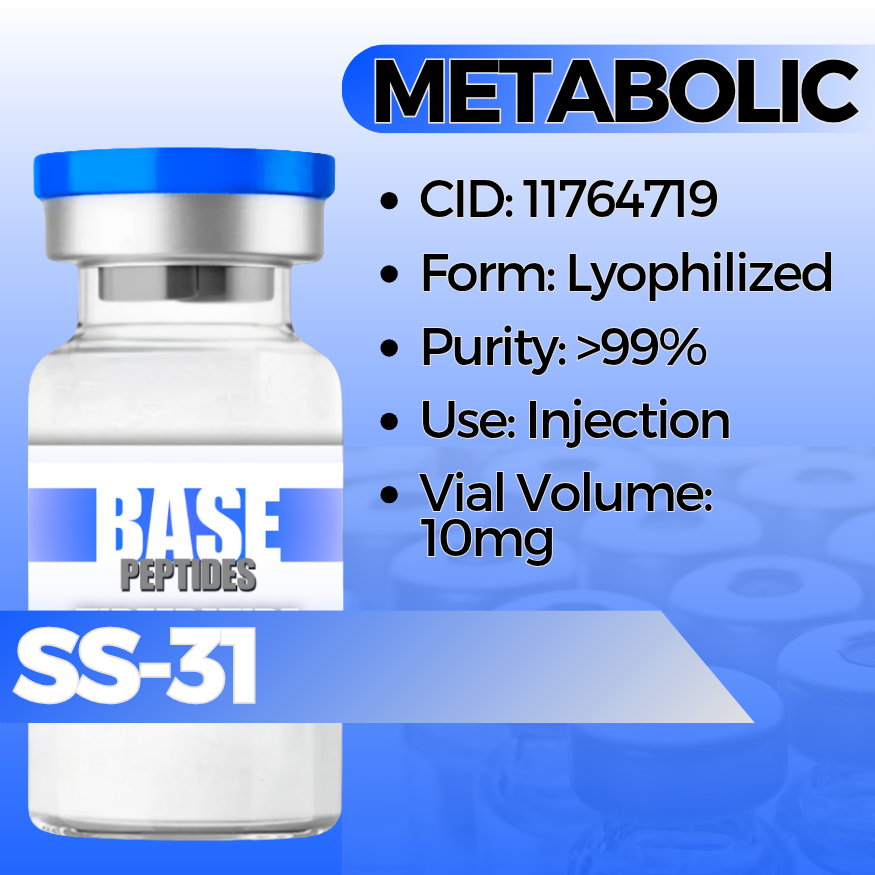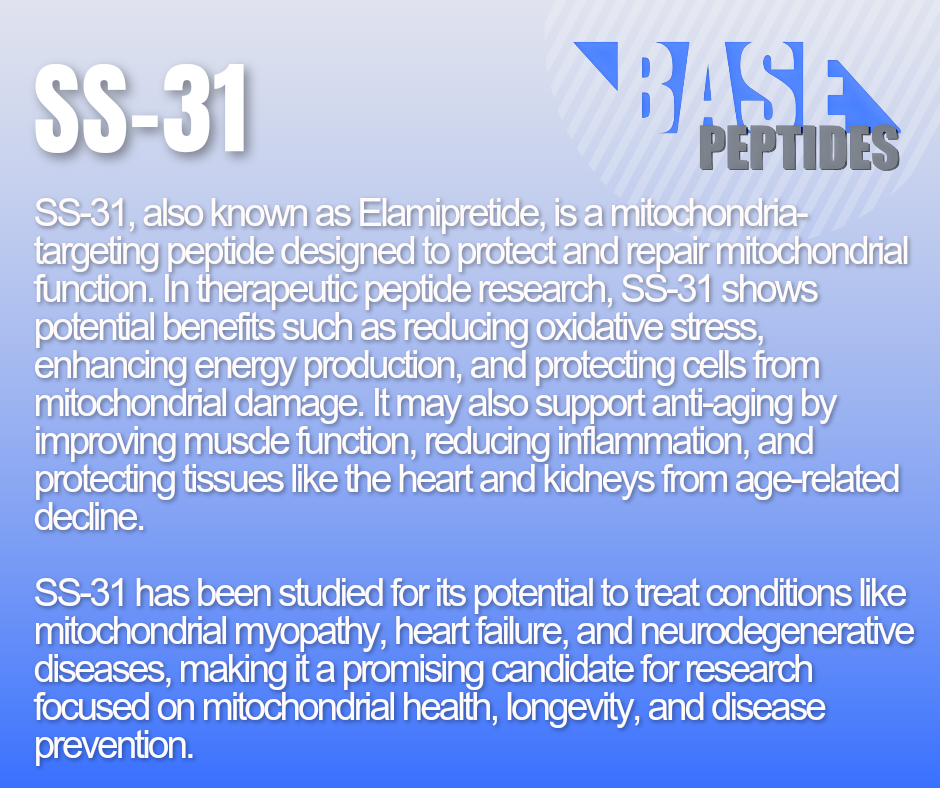SS-31
SS-31
Base Peptides are intended for licensed medical professionals and experienced researchers. Reconstitution required. Dosing and use instructions are not provided.
Regular price
$58.00
Regular price
Sale price
$58.00
Shipping calculated at checkout.
Quantity
Couldn't load pickup availability
SS-31 — Mitochondria-Targeted Tetrapeptide
SS-31 is a cell-permeable, aromatic-cationic tetrapeptide that concentrates in mitochondria and binds cardiolipin. In research, it’s used to explore mitochondrial bioenergetics, ROS control, membrane potential, and cell-stress adaptation.
Identifiers
- Formula / MW: C32H49N9O5 · ≈ 639.8 Da
- Sequence: D-Arg-Dmt-Lys-Phe-NH2 (Dmt = 2,6-dimethyl-Tyr)
How It Works (Plain English)
- SS-31 selectively associates with cardiolipin in the inner mitochondrial membrane, supporting cristae structure and electron-transport efficiency.
- It can reduce excessive ROS and help maintain membrane potential (Δψm) during stress, improving ATP generation. [oai_
- Structure–activity work maps how aromatic–cationic features drive mitochondrial targeting and function.
Why Researchers Use It
- To model mitochondrial protection in oxidative or ischemic stress assays.
- To study bioenergetics (oxygen consumption, ATP, Δψm) in cell and tissue systems.
- To examine neuroinflammation/behavior links in LPS or toxin paradigms.
Key Studies — What Was Tested, What Changed, Why It Matters
Cardiolipin interaction & membrane energetics
- What was tested: Biophysical and cell studies of SS-31 binding to cardiolipin-rich membranes under calcium/oxidative stress.
- What changed: Stabilized membrane interfaces, lower energetic cost under Ca2+ load, and improved ETC coupling.
- Why it matters: Provides a mechanism for preserving Δψm and ATP output during stress exposures.
Oxidative stress & bioenergetics rescue
- What was tested: SS-31 in mitochondrial injury models (cells/tissues) tracking ROS, ATP, and respiration.
- What changed: Reduced ROS, restored oxygen-consumption rates, and better ATP preservation vs controls.
- Why it matters: Demonstrates a practical tool for studying mitochondrial resilience across tissues.
Neuroinflammation & behavior (context)
- What was tested: LPS-induced cognitive-impairment models with mitochondrial readouts.
- What changed: Improved mitochondrial function and better memory performance in rodents.
- Why it matters: Connects mitochondrial health with brain function in inflammatory stress models.
Potential Research Applications
Bioenergetics
- OCR/ECAR, ATP production, Δψm assays
- Cardiolipin oxidation & cristae morphology
Stress & Injury Models
- Ischemia-reperfusion, Ca2+ overload, oxidative injury
- Muscle, heart, kidney, and neuron models
Neuro & Immunometabolism
- LPS/toxin paradigms; behavior + mitochondrial endpoints
- Mitophagy and quality-control pathways
Synergistic Peptides (for Study Design)
MOTS-c
- Why pair: AMPK-centric energy signaling complements SS-31’s cardiolipin/ETC support.
- Angle: Combine AMPK and mitochondrial-membrane metrics for integrated metabolism readouts.
GHK-Cu
- Why pair: Tissue/ECM remodeling markers with mitochondrial stress endpoints.
- Angle: Oxidative-stress gene panels + imaging of matrix and cristae organization.
9-ME-BC
- Why pair: Dopaminergic & microglial assays benefit from mitochondrial support.
- Angle: Pair neurite/microglia endpoints with Δψm and ATP metrics.
Design Notes
- Report salt form (free base vs HCl) and vehicle; light/temperature can affect stability.
- Include both acute (minutes–hours) and chronic (days) time points.
- Use cardiolipin/ROS controls (e.g., peroxidation assays) for mechanism clarity.
Known Concerns (Context)
- Handling: Protect from light; prepare fresh aliquots for reproducibility.
- Model dependence: Outcomes vary by tissue and injury model; predefine primary endpoints.
- General: Research use only; not for human consumption or therapeutic use.
Specifications & Handling
- Form: Lyophilized powder (lot-coded)
- Purity: ≥ 99% (HPLC/MS verified)
- Storage: ≤ −20 °C; protect from light/moisture
- In solution: Aliquot promptly; avoid repeat freeze–thaw
- Additives: None unless specified per lot
- Packaging: Tamper-evident; research-only labeling
Regulatory & Use Notice
Sold for laboratory research use only. Not for human consumption, medical, or veterinary use. No human-use instructions are provided. Buyer is responsible for safe handling and regulatory compliance.
SS-31 (Elamipretide) Peptide Research | Mitochondria-Targeted Tetrapeptide | Cardiolipin, ROS & ATP Studies






